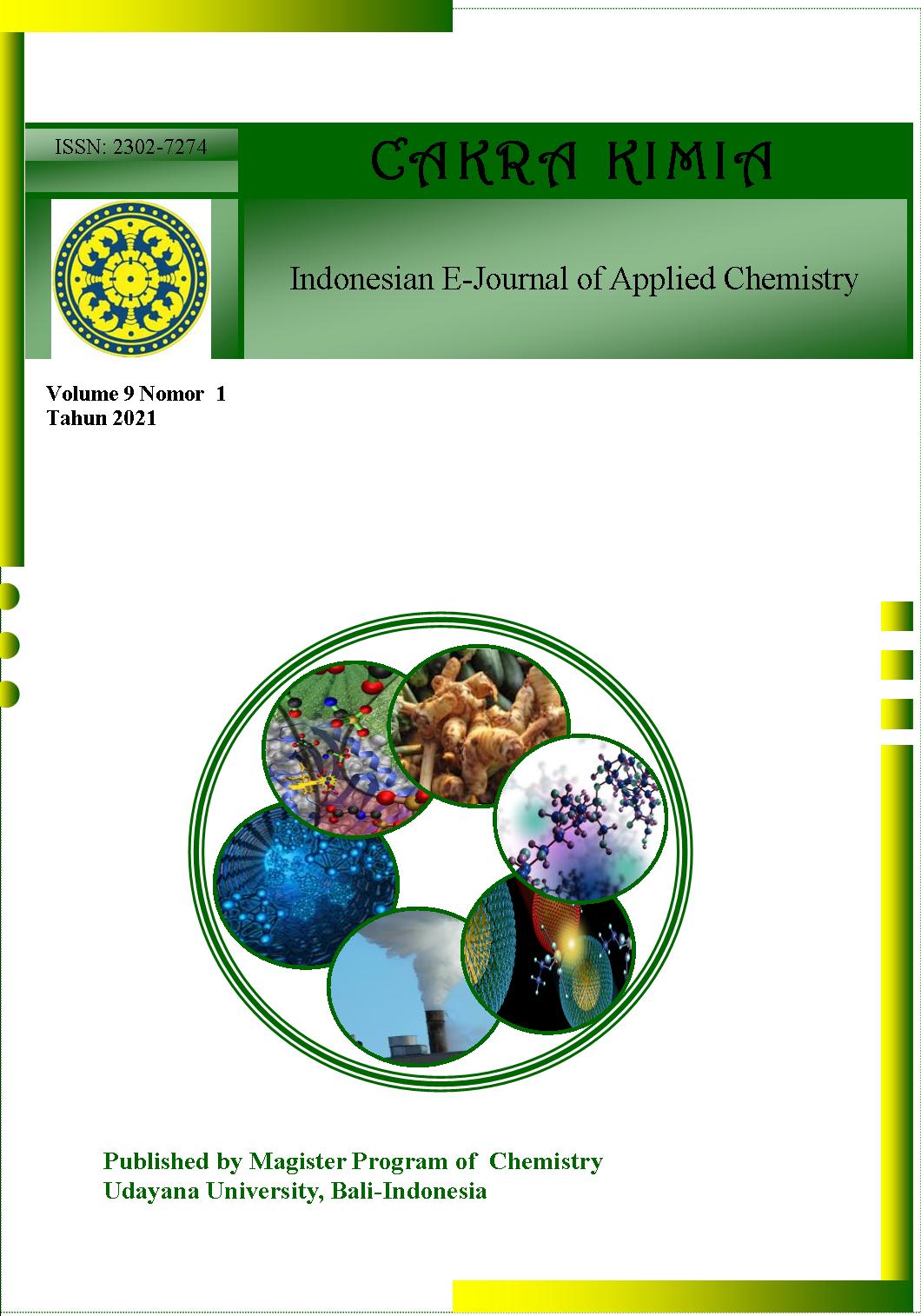PEMANFATAAN CANGKANG TELUR AYAM SEBAGAI MATERIAL DASAR DALAM SINTESIS HIDROKSIAPATIT DENGAN METODE PRESIPITASI BASAH
Abstract
ABSTRAK: Sintesis hidroksiapatit (HAp) dari cangkang telur ayam melalui proses presipitasi basah telah berhasil dilakukan. Tujuan dari penelitian ini adalah untuk mendapatkan kondisi proses yang optimal dan juga untuk mengetahui pengaruh rasio mol Ca/P dan suhu sintesis terhadap karakteristik HAp. Bubuk cangkang telur ayam dikalsinasi untuk mendapatkan CaO yang kemudian direaksikan dengan diammonium hidrogen fosfat dengan menggunakan air sebagai pelarut. Proses presipitasi dilakukan dengan sistem tertutup untuk menghindari terjadinya pelarut hilang saat pemanasan di atas titik didih pelarut. Sampel kemudian diambil untuk dikarakterisasi dengan menggunakan FTIR (Fourier Transform Infrared), XRD (X-Ray Diffraction), dan SEM (Scanning Electron Microscopy). Kelompok fungsional diamati di FTIR HAp yang disintesis adalah fosfat (PO43-), hidroksil (OH-), karbonat (CO32-), dan hidrogen fosfat (HPO42-). Kelompok fungsional ini menunjukkan bahwa HAp telah terbentuk. Data XRD menunjukkan puncak utama untuk HAp yang memperkuat kebenaran karakterisasi FTIR. SEM digunakan untuk mengamati morfologi HAp hasil sintesis yang terdiri dari aglomerat. Kondisi terbaik dalam sintesis ini terjadi pada perbandingan mol Ca/P sebesar 1,60 pada suhu 160oC
ABSTRACT: Synthesis of hydroxyapatite (HAp) from eggshell by precipitation method has been successfully done. The aim of this research was to get the optimum process condition and also to investigate the influence of the Ca/P mole ratio andthe synthesis temperature toward HAp characteristic. The powder of eggshell was calcined to get CaO which then was reacted with diammonium hydrogen phosphate by using water as solvent. Precipitation process was done by closed system in order to avoid the solvent be lost while heating up above the solvent’s boiling point. The samples then were characterized by using FTIR (Fourier Transform Infrared), XRD (X-Ray Diffraction), and SEM (Scanning Electron Microscopy). The functional groups were observed in the FTIR of the synthesized HAp are phosphate (PO43-), hydroxyl (OH-), carbonate (CO32-), and hydrogen phosphate (HPO42-). These functional groups indicate that HAp has been formed. XRD data showed the main peaks for HAp that strenghtened the truth of FTIR characterization. SEM was used to observe the morphology of the synthesized HAp that consisted of agglomerates. The best conditions in this synthesis occured at Ca/P mole ratio of 1,60 and the synthesis temperature of 160oC.
Downloads
References
[2] Mozartha M, Praziandithe M, Sulistiawati. 2015. Pengaruh penambahan hidroksiapatit dari cangkang telur terhadap kekuatan tekanan glass ionomer cement. Jurnal B-Dent. 2(1):75-81.
[3] Toibah AR, Misran F, Shaaban A, Mustafa Z. 2019. Effect of pH condition during hydrothermal synthesis on the properties of hydroxyapatite from eggshell waste. Journal of Mechanical Engineering and Sciences. 13(2):4958-4969.
[4] Agarwal A, Gupta PK. 2015. Adsorption study of Cr(II) from aqueous solution using animal bone charcoal as low cost adsorbent. International Journal Engineering Technology, Management and Applied Sciences. 3(1):151-163.
[5] Amalia V, Hadisantoso EP, Hidayat D, Diba RF, Dermawan MF, Tsaniyah SW. 2018. Isoalasi dan karaterisasi hidroksiapatit dari limbah tulang hewan. Alchemy Journal of Chemistry. 5(4):114-119.
[6] Pinangsih AC, Wardhani S, Darjito. 2014. Sintesis biokeramik hidroksiapatit Ca10(PO4)6(OH)2 dari limbah tulang sapi menggunakan metode sol-gel. Kimia Student Journal. 1(2):203-209.
[7] Wadu I, Soetjipto H, Cahyanti MN. Sintesa dan penentuan kadar kalsium-fosfat hidroksiapatit (HAp) dari kerabang telur ayam. Jurnal Kimia dan Pendidikan Kimia. 3(3):1-5.
[8] Noviyanti AR, Haryono, Pandu R, Eddy DR. 2017. Cangkang telur ayam sebagai sumber kalsium dalam pembuatan hidroksiapatit untuk aplikasi graft tulang. Chimica et Natura Acta. 5(3):107-111.
[9] Pankew P, Hoonnivathana E, Limsuwan P, Naemchanthara K. 2010. Temperature effect phosphate synthesized from chicken eggshells and amonnium phosphate. ApplSci. 10(24):3337-3342.
[10] Dahlan K, Prasetyanti F, Sari YW. 2009. Sintesis Hidroksiapatit dari Cangkang Telur Menggunakan Dry Metode. J. Biofisika. 5(2):71-78.
[11] Singh V, Meeraj N. 2012. Synthesis of Nano Crystalline Hydroxyapatite from Egg Shells by Combustion Method. J. Science and Engineering Investigations 1(3): 92-95.
[12] Thamaraiselvi TV, Prabakaran K, Rajeswari S. 2006. Synthesis of Hydroxyapatite that Mimic Bone Mineralogy. Trends Biomater.Artif. Organs. 19(2):81-83.
[13] Manafi AM, Joughehdoust S. 2009. Synthesis of Hydroxyapatite Nanostructure by Hydrothermal Condition for Biomedical Application. Iranian J Pharmaceutechal Science 5(2):89-94.
[14] Hatha, AAM, Christi, KS, Singh R. & Kumar S. 2005. Bacteriology of the fresh water bivalve clam Batissa violacea (Kai) sold in the Suva Market. The South Pacific Journal of Natural Science. 23 48-50.
[15] Sasikumar S, Vijayaraghavan R. 2006. Low Temperature Syntesis of Nanocrystaline Hydroksiapatite from Egg Shells by Combustion Method. Trens Biomater.Artif.Organs 19(2):70-73
[16] Dahlan K, Prasetyanti F, Sari YW. 2009. Sintesis Hidroksiapatit dari Cangkang Telur Menggunakan Dry Metode. J. Biofisika 5(2):71-78.
[17] Anggresani L., Perawati S., Rahayu I.J. Limbah tulang ikan tenggiri (Scomberomorus guttatus) sebagai sumber kalsium pada pembuatan hidroksiapatit, Jurnal Katalisator. 2019, 4(2), 133-140.
[18] Dedourkova T., Zelenka J., Zelenkova M., Benes L., Svoboda L. Synthesis of sphere-like nanoparticles of hydroxyapatite, Procedia Engineering. 2012, 42, 1816–1821.
[19] Poinern G., Brundavanam R., Fawcett D. Nanometre scale hydroxyapatite ceramics for bone tissue engineering, American Journal of Biomedical Engineering. 2013, 3(6):148-168.
[20] Szczes A., Holysz L., Chibowski E. Synthesis of hidroxyapatite for biomedical applications, Advances in Colloid and Interface Science. 2017, 249, 321-330.



 Petunjuk Penulisan
Petunjuk Penulisan
